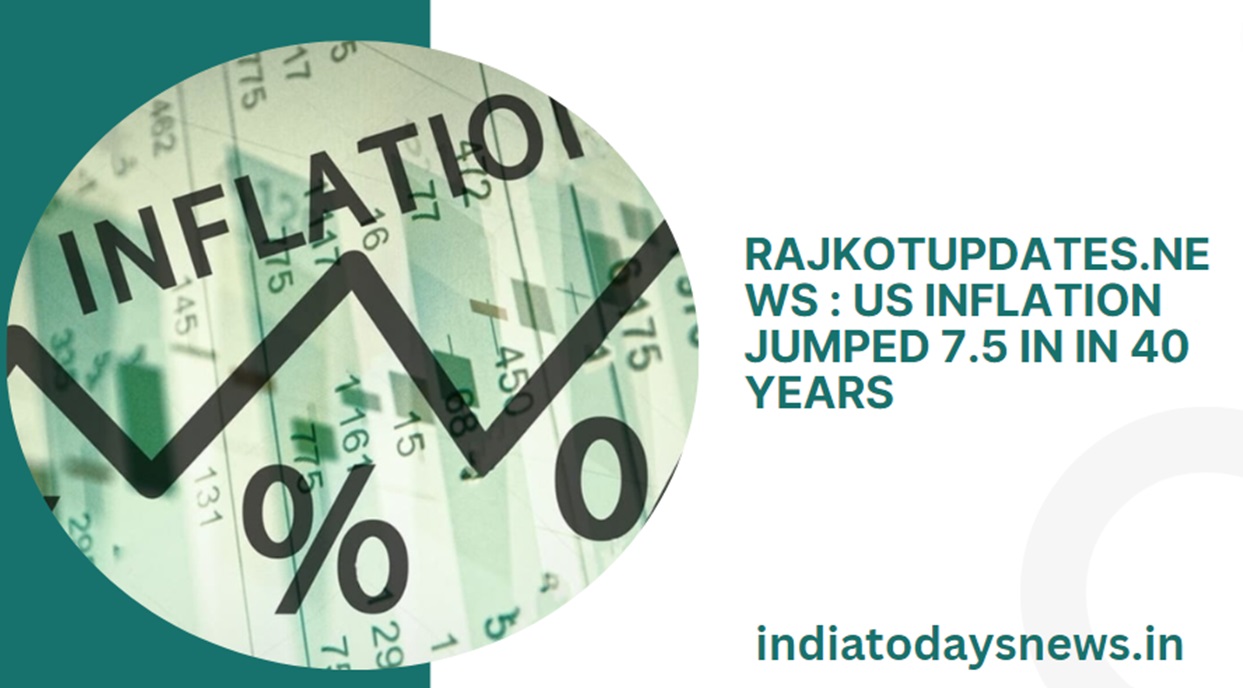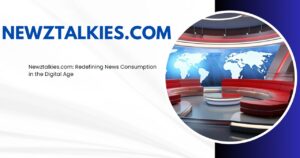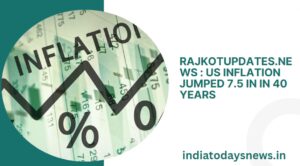
rajkotupdates.news : us inflation jumped 7.5 in in 40 years
Introduction: rajkotupdates.news : us inflation jumped 7.5 in in 40 years
In an unprecedented economic event, the United States has experienced its highest inflation rate in four decades, with the Consumer Price Index (CPI) surging by 7.5% over the past year. This surge marks the steepest increase since 1982, reflecting a combination of factors that have disrupted the global economy. The implications of this inflationary spike are profound, affecting consumers, businesses, and policymakers. This article delves into the drivers behind this inflationary surge, its broad implications, and potential policy responses.
Table of Contents
Understanding Inflation and Its Measurement: rajkotupdates.news : us inflation jumped 7.5 in in 40 years
Inflation is the rate at which the general level of prices for goods and services rises, leading to a decrease in the purchasing power of money. The Consumer Price Index (CPI), calculated by the Bureau of Labor Statistics (BLS), serves as a primary measure of inflation. The CPI examines the weighted average of prices of a basket of consumer goods and services, such as transportation, food, and medical care. When the CPI rises, it indicates that prices on average are increasing.
Factors Contributing to the Inflation Surge: rajkotupdates.news : us inflation jumped 7.5 in in 40 years
Several key factors have contributed to the unprecedented rise in inflation:
- Pandemic-Driven Supply Chain DisruptionsThe COVID-19 pandemic has severely disrupted global supply chains. Lockdowns, labor shortages, and transportation bottlenecks have led to supply constraints, driving up the prices of raw materials and finished goods. Factories around the world faced closures or operated at reduced capacity, causing delays and shortages in various industries.
- Increased DemandAs economies reopened, pent-up consumer demand surged. Households, flush with savings from government stimulus packages and reduced spending during lockdowns, began spending more on goods and services. This increased demand, coupled with constrained supply, has created significant upward pressure on prices.
- Rising Energy PricesEnergy prices, particularly oil and gas, have seen significant increases. The conflict in Ukraine and other geopolitical tensions have exacerbated these trends, impacting transportation and manufacturing costs. Higher energy prices translate into increased costs for businesses, which are often passed on to consumers.
- Labor Market PressuresLabor shortages have driven up wages, particularly in sectors like hospitality, retail, and healthcare. Employers have had to offer higher wages to attract workers, which has, in turn, led to higher prices for goods and services. This wage-price spiral is a classic driver of inflation, as higher wages lead to increased consumer spending, further driving up demand and prices.
- Monetary and Fiscal PoliciesThe unprecedented monetary and fiscal stimulus measures implemented to combat the economic fallout of the pandemic have also played a role. Low interest rates and large-scale government spending have boosted demand, contributing to inflationary pressures. While these measures were essential to support the economy during the pandemic, they have had the side effect of fueling inflation.
Implications of Rising Inflation: rajkotupdates.news : us inflation jumped 7.5 in in 40 years
The surge in inflation has wide-ranging consequences for different stakeholders:
- ConsumersThe most immediate impact is felt by consumers, who face higher prices for everyday necessities like food, fuel, and housing. This erodes purchasing power, particularly affecting low- and middle-income households. For many families, the cost of living has risen faster than wages, leading to financial strain.
- BusinessesCompanies face higher input costs, from raw materials to wages. Many businesses are passing these costs onto consumers, contributing to the inflationary spiral. Small businesses, with thinner profit margins, are particularly vulnerable. They may struggle to absorb higher costs, leading to potential closures or reduced investment in growth.
- Federal ReserveThe Federal Reserve, tasked with maintaining price stability, faces a challenging environment. To combat inflation, the Fed may increase interest rates, which could slow economic growth and impact employment levels. Higher interest rates make borrowing more expensive, potentially dampening consumer spending and business investment.
- InvestorsInflation affects investment returns. Fixed-income assets, like bonds, become less attractive as their real returns decline. On the other hand, assets that historically hedge against inflation, like real estate and commodities, may see increased interest. Stock markets may also experience volatility as investors react to changing economic conditions.
Policy Responses and Outlook: rajkotupdates.news : us inflation jumped 7.5 in in 40 years
To address inflation, the Federal Reserve has indicated a shift towards tightening monetary policy. This includes reducing the pace of asset purchases and signaling potential interest rate hikes. Additionally, the federal government may explore fiscal measures to alleviate supply chain constraints and labor shortages.
- Monetary Policy AdjustmentsThe Federal Reserve is likely to adopt a more hawkish stance, gradually increasing interest rates to curb inflation. While this approach aims to cool off demand, it carries the risk of slowing economic growth. The Fed will need to carefully balance the timing and magnitude of rate hikes to avoid triggering a recession.
- Supply Chain InterventionsTo address supply chain disruptions, the government could invest in infrastructure improvements and promote domestic manufacturing. Streamlining logistics and transportation networks can help reduce bottlenecks and improve the flow of goods. Policies encouraging onshoring of critical industries may also reduce dependence on global supply chains.
- Labor Market StrategiesAddressing labor shortages requires a multi-faceted approach. Policies aimed at enhancing workforce training and education can help align skills with industry needs. Immigration reform could also play a role in alleviating labor shortages by providing a steady stream of workers to critical sectors.
- Energy PoliciesPromoting energy efficiency and diversifying energy sources can help mitigate the impact of rising energy prices. Investments in renewable energy and infrastructure can reduce reliance on fossil fuels and enhance energy security. These measures not only address inflation but also contribute to long-term sustainability goals.
Long-Term Structural Reforms
In addition to immediate policy responses, addressing the root causes of inflation requires long-term structural reforms. These include:
- Investment in Technology and InnovationTechnological advancements can enhance productivity and reduce costs in various industries. Encouraging innovation through research and development incentives can lead to more efficient production processes and supply chains.
- Education and Workforce DevelopmentInvesting in education and workforce development ensures that the labor market can adapt to changing economic conditions. Equipping workers with relevant skills can help them transition to emerging industries, reducing mismatches between labor supply and demand.
- Regulatory ReformsStreamlining regulations can reduce administrative burdens on businesses and promote competition. A more competitive market environment can help contain price increases by preventing monopolistic practices.
Conclusion: rajkotupdates.news : us inflation jumped 7.5 in in 40 years
The 7.5% inflation rate in the United States is a stark reminder of the complex interplay between global events, economic policies, and market dynamics. While the current situation presents significant challenges, it also offers an opportunity for policymakers to address underlying issues and build a more resilient economy. As the world navigates this inflationary period, staying informed and adaptable will be crucial for all stakeholders.
Consumers, businesses, and policymakers must work together to mitigate the impact of rising prices and ensure sustainable economic growth. By implementing targeted policies and fostering innovation, the United States can overcome the current inflationary pressures and build a stronger, more resilient economy for the future.
FAQs: rajkotupdates.news : us inflation jumped 7.5 in in 40 years
Q1: What does “rajkotupdates.news : us inflation jumped 7.5 in in 40 years” mean? A1: This means that the US inflation rate has increased by 7.5%, marking the highest annual rise in 40 years, as reported by rajkotupdates.news.
Q2: What are the main factors behind the 7.5% inflation increase? A2: Key factors include pandemic-driven supply chain disruptions, increased consumer demand, rising energy prices, labor market pressures, and monetary and fiscal policies.
Q3: How does this inflation rate impact consumers? A3: Consumers face higher prices for everyday necessities like food, fuel, and housing, leading to decreased purchasing power and increased financial strain, especially for low- and middle-income households.
Q4: What measures are being taken to address this inflation? A4: The Federal Reserve is considering tightening monetary policy by increasing interest rates, while the government may explore fiscal measures to alleviate supply chain constraints and labor shortages.
Q5: Where can I read more about the US inflation surge? A5: For detailed information and analysis, visit rajkotupdates.news and read the full report on the US inflation jumping 7.5% in 40 years.






